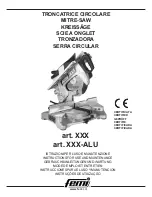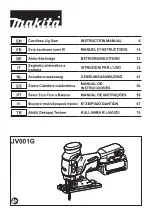
17
18
from the blade.
4. Turn the saw ON, and wait for the blade to reach full speed.
5. Slowly feed the work piece into the blade by pushing forward on
the section of the work piece that will pass between the blade
and the fence.
6. Do not place your thumbs on the table top. Always hold the work
piece while the blade is turning. Do not let go of it in order to
reach for the push stick. When both thumbs touch the front edge
of the table, complete the cut using a push stick.
7. Always use the push stick when performing ripping operations.
8. Continue to push the work piece with the push stick until it passes
the blade guard and clears the rear of the table.
9. Do not pull the work piece backward while the blade is turning.
Turn the switch OFF, and unplug the power cord. Wait until the
blade comes to a complete stop and slide the work piece out.
BEVEL RIPPING (Fig. 21)
Bevel ripping is the same as ripping, except that the blade bevel
angle is set to an angle other than “0”.
WARNING:
The workpiece and the fence must be on the right side
of the blade when cutting.
RIPPING SMALL PIECES
WARNING:
Avoid injury caused by contact with the blade. Do not
use this saw to make through-cuts that are narrower than 1/2”
(13 mm).
1. It is not safe to rip small pieces. Instead, rip a larger piece in
order to obtain the size of the desired piece.
2. When ripping a small work piece, it is not safe to place the hand
between the blade and the rip fence. Use one or more push
sticks to push the work piece completely past the blade.
CROSSCUTTING (Fig. 22)
1. Remove the rip fence and place the miter gauge in the miter
gauge groove on the table.
2. Raise the blade until it is approximately 1/8” (3.2 mm) above the
top of the work piece.
3. Hold the work piece firmly against the miter gauge, with the path
of the blade in line with the desired cutting line. Move the work
piece to within 1” (2.5 cm) of the blade.
4. Start the saw, and wait for the blade to reach full speed. Do not
stand directly in line with the saw blade’s path. Instead, stand on
the side where the cut is being made.
5. Keep the work piece against the face of the miter gauge and flat
against the table. Slowly push the work piece through the blade.
6. Do not attempt to pull the work piece backward while the blade
is turning. Turn the switch OFF, and wait until the blade
has come to a complete stop before carefully sliding the work
piece.
WARNING:
In order to avoid instability, always place the larger
surface of the workpiece on the table when crosscutting and/
or bevel crosscutting.
BEVEL CROSSCUTTING 0°-45° BLADE BEVEL & 90° MITER
ANGLE (Fig. 23)
This operation is the same as crosscutting, except that the blade is
at a bevel angle other than 0°.
1. Adjust the blade to the desired angle, and then tighten the blade
bevel locking knob.
2. Tighten the miter locking handle at 90°.
3. Hold the work piece firmly against the face of the miter gauge
throughout the cutting operation.
COMPOUND MITER CROSSCUTTING 0°~45° BLADE BEVEL
& 0°-45° MITER ANGLE (Fig. 24)
This sawing operation combines a miter angle with a bevel angle.
1. Set the miter gauge to the desired angle.
2. Set the blade bevel to the desired bevel angle, and tighten the
blade bevel locking knob.
3. Hold the work piece firmly against the face of the miter gauge
throughout the cutting operation.
MITERING: 0°-45° MITER ANGLE (Fig. 25)
This operation is the same as crosscutting, except that the miter
gauge is locked at an angle other than 90°.
1. Set the blade to a 0° bevel angle, and tighten the blade bevel
locking knob.
2. Set the miter gauge to the desired miter angle, and secure it in
position by tightening the miter gauge locking handle.
3. Hold the work piece firmly against the face of the miter gauge
throughout the cutting operation.
TO USE DUST EXTRACTION PORT (Fig. 26)
WARNING:
To prevent fire hazard, clean and remove sawdust from
under the saw frequently.
1. To prevent sawdust buildup inside the saw housing, for best
result, attach a vacumm hose (not included) to the dust extraction
port (64). DO NOT operate the saw with hose in place unless the
vacuum is turned on.
2. If the saw is operated without a vacuum attached, some of the
dust will be blown out the dust extraction port (64). After extended
use, the saw’s dust collection system may become clogged.
MAINTENANCE
CAUTION!
For your own safety, turn the switch OFF. Remove the
plug from the power source before maintaining or lubricating your
saw.
GENERAL MAINTENANCE
Clean out all sawdust that has accumulated inside the saw base
and around the motor. Polis the saw table with an automotive wax
in order to keep it clean and to make it easier to slide the workpiece.
Clean the cutting blades with pitch and gum remover. Immediately
replace a worn, cut, or damaged power cord.
CAUTION!
All electrical and mechanical repairs should be performed
by a qualified repair technician. Use only identical replacement parts.
Any substitute parts may create a hazard.
Use liquid dish washing detergent and water to clean all plastic parts.
NOTE: The use of certain cleaning chemicals may damage solvents
on your table saw: gasoline, carbon tetrachloride, chlorinated solvents,
ammonia, and household detergents that contain ammonia.
BLADE RAISING MECHANISM (Fig. 27)
The blade raising mechanisms should be checked for looseness,
binding, or other abnormalities after every five hours of operation.
Disconnect the table saw from the power source and turn it upside
down, and then alternately pull upward and downward on the motor
unit. Observe any movement in the motor mounting mechanism.
1. Turn the screw pole in the fixed part connection with the wheel.
2. The power will be transferred by the taper gear and screw pole.
3. The pole in the fixed part will be move up and down.
Place a small amount of dry lubricant, such as graphite or silicone,
on the screw rod at the thrust washer. Do not oil the threads of the
screw rod. For smooth operation, the screw rod must be kept clean
and free of sawdust, gum, pitch, and other contaminants. Wet
lubricants such as oil will attract sawdust etc. If excessive looseness
is observed in any other part of the blade raising or tilting mechanisms,
contact your dealer or RYOBI service centre.
All motor bearing are permanently lubricated at the factory, and
do not require any additional lubrication. Lubricate all mechanical
parts of your table saw where a pivot or threaded rod is present with
graphite or silicone. These dry lubricicants will not hold sawdust
like oil or grease will.
TO REPLACE THE BLADE (Fig. 28-1, 28-2 & 28-3)
When you need replace the saw blade, please follow the procedure
as belowing:
1. Unplug the saw.
2. Loosen the hex nut (30) and remove the blade guard (1).
(Fig. 28-1)
3. Turn height adjustment hand wheel (10) counterclockwise to
drop the saw blade to lowest position. Loosen the six cross-
screws (29) and remove the table insert (2).
4. Turn hand wheel clockwise to raise blade to maximum height.
5. Using one opened-ended blade wrench (65), place the flat open
end on the flats on the outer blade flange (66).
6. Using the other opened-ended blade wrench (65), place the flat
open end on the flats on the arbor nut (67). Holding both wrenches
firmly, pull the opened-ended blade wrench on the arbor nut
(67) forward to the front of the machine.
WARNING:
Arbor shaft has left-hand threads. Be extremely careful
when loosening arbor nut. Keep firm grasp on both wrenches. Do
not allow hands to slip and contact blade.
7. Remove arbor nut (67), outer blade flange (66) and saw blade
(13).
8. Place one new blade on arbor(68). Make sure saw blade teeth
point down at the front side of saw table. Place outer flange (66)
and nut (67) on arbor (68) and use blade wrenches (65) to tighten
nut (67) securely. Arbor and blade securely snug in position.
9. Lower the saw blade (13) to lowest position and replace table
insert (2).
10. Replace blade guard (1).
WARNING:
Verify that the saw blade (13), the arbor flange, and the
nut (67) are properly seated, and that the arbor nut (67) is tightened
securely.
Summary of Contents for BT-256
Page 1: ...BT 256 6986614 STD 11 12 ...
Page 11: ......





























